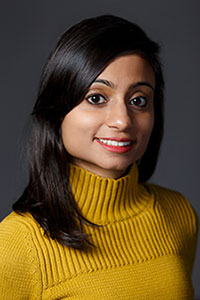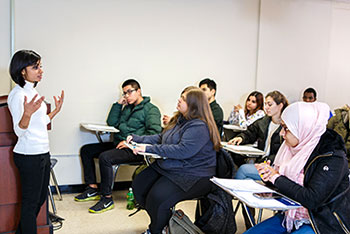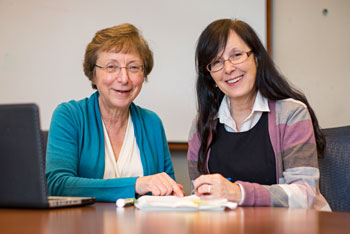

BETTR Training Yields Success
BETTR Betters Education Through Preparation for Serving Underrepresented Students
Becoming a professor is tough. That’s because competition among postdoctoral fellows for faculty positions is fierce.

Punita Bhansali, Ph.D.However, Einstein is striving to give its postdocs a distinct advantage— as one of just 19 institutions nationwide receiving an Institutional Research and Academic Career Development Award (IRACDA) from the National Institutes of Health that allows them to offer eligible postdocs an unparalleled training opportunity.
IRACDA funds the Bronx–Einstein Training in Teaching and Research (BETTR) program. Fellows in the program, identified by the NIH as “scholars,” enjoy a unique postdoctoral path, combining laboratory research with instruction in teaching through coursework and firsthand classroom experience. The program allows postdocs to fulfill their academic dreams.
Punita Bhansali, Ph.D., can speak to the benefits of being a BETTR fellow. Last January, the former Einstein postdoc accepted a position as an assistant tenure-track professor at Queensborough Community College (QCC). “It’s an exciting opportunity,” she said. “I was a little nervous, but definitely excited.”
Preparing for a New Role
Dr. Bhansali, who served as a postdoctoral researcher in the laboratory of Wei Liu, Ph.D., attributes much of her recent career success to her BETTR fellowship, which paid for the last two years of her postdoctoral training and provided invaluable teaching experience.
Teaching is a mainstay of most faculty appointments, so Dr. Bhansali’s participation in BETTR made her a more competitive applicant. From her increased fluency in educational jargon to the innovative teaching methods she modeled for the hiring committee, the influence of the fellowship was noticeable. “The department chair told me it was clear that I had a different type of training because of the BETTR program,” she said.
Aiming for STEM Parity
While BETTR helps researchers like Dr. Bhansali reach their career goals, the program is ultimately designed to tackle a different challenge: increasing ethnic diversity in the fields of science, technology, engineering and math (STEM). According to a published by the U.S. Department of Education, black and Hispanic students successfully complete STEM degrees at lower rates than their Asian and white counterparts. Moreover, a 2013 American Community Service Report, published by the U.S. Census Bureau, found that these groups are underrepresented in many STEM fields.

Dr. Bhansali teaching at Queensborough Community CollegeBETTR partners with Eugenio María de Hostos Community College and Lehman College, undergraduate institutions in the Bronx with many students from diverse and often lower-income groups traditionally underrepresented in STEM. The program prepares BETTR scholars to help meet the unique challenges facing these students.
Dr. Bhansali spent a year teaching biology to undergraduates at Hostos. “The biggest advantage is that we actually taught at a minority-serving institution,” she said. “I gained so much experience working with students from all different backgrounds.”
How did this exposure affect her approach to teaching? “Many of my students are immigrants who don’t have a strong background in English, or never took a science course in high school,” she explained. “I can’t always take for granted that they’ll come in with some of the basic foundational concepts in science. I also have to be ready to step in if they struggle with certain English words.”
This awareness enhances her connection with the diverse students she now teaches at QCC. “I have more empathy and patience in helping students overcome academic challenges,” she noted. “They may learn less material than I had anticipated, but I try to ensure they’re learning the concepts well.”
BETTR Teaching Practices
While the BETTR experience deepened Dr. Bhansali’s ties to students, it also sharpened her analytical skills in the classroom. Dr. Bhansali now approaches teaching like laboratory work: using the scientific method. “Dr. Nelson Nunez Rodriguez, a mentor of mine in BETTR, once told me that I should think of each problem in the classroom as a research question to study,” she said. “That insight has really stuck with me.”
Working with Dr. Nunez Rodriguez and fellow BETTR scholar Dr. Travis Bernardo, she conducted education experiments in chemistry classrooms at Hostos, teaching students to write lab reports and build literacy skills in preparation for scientific careers. She intends to incorporate this evidence-based approach at QCC.
As Dr. Bhansali approaches her third semester as a full-time assistant professor, she’s already contemplating ways to channel her zeal for helping minority students into a full-blown research platform. “The department encourages us to try out new teaching practices,” she said. “I’ve started to implement more active learning techniques, such as clickers, case studies, asking students to come up with research problems, even Jeopardy. Eventually, I’d like to determine ways to measure how well the interventions actually work.”
She added, “I’m also thinking about collaborating with our English department to help students with their writing skills in a science classroom. Ultimately, I’m open to any idea that can retain STEM students.”
She hopes her classroom research will lead to publication, a requirement for gaining tenure. For now, though, Dr. Bhansali is excited about the next leg of her professional journey. “The classrooms at QCC are so diverse, which I love. I get to know each of my students, and I feel as though I have the opportunity to make a real impact on their careers and growth.”
A BETTR Future

Drs. Barbara Birshtein and Dianne Cox co-direct the BETTR program“Having specific training in teaching that enhances one’s scientific knowledge offers a novel combination that provides a sound foundation for effective teaching and allows BETTR scholars to be optimistic in their job searches,” observed Dr. Barbara Birshtein, co-director of BETTR, director of training grant support programs, and professor emerita of cell biology.
“We’re now beginning the sixth year of the BETTR program, and we’ve had 16 scholars complete their training thus far,” said Dr. Dianne Cox, co-director of BETTR and professor of anatomy and structural biology and of developmental and molecular biology. “More than 60 percent of these scholars have gotten academic positions, with more than half receiving tenure track appointments. And others have started successful careers in biopharma and science communications, as well as begun a senior postdoctoral position at the National Institutes of Health.”
Einstein postdocs interested in applying to the BETTR program should inquire with Drs. Birshtein and Cox. Participants must be a U.S. citizen or green card holder in their first year of post-degree work.
Editor’s Note: All photos with this story provided courtesy of Leo Correa (Queensborough Community College, CUNY)
Posted on: Monday, February 5, 2018

Tablet Blog